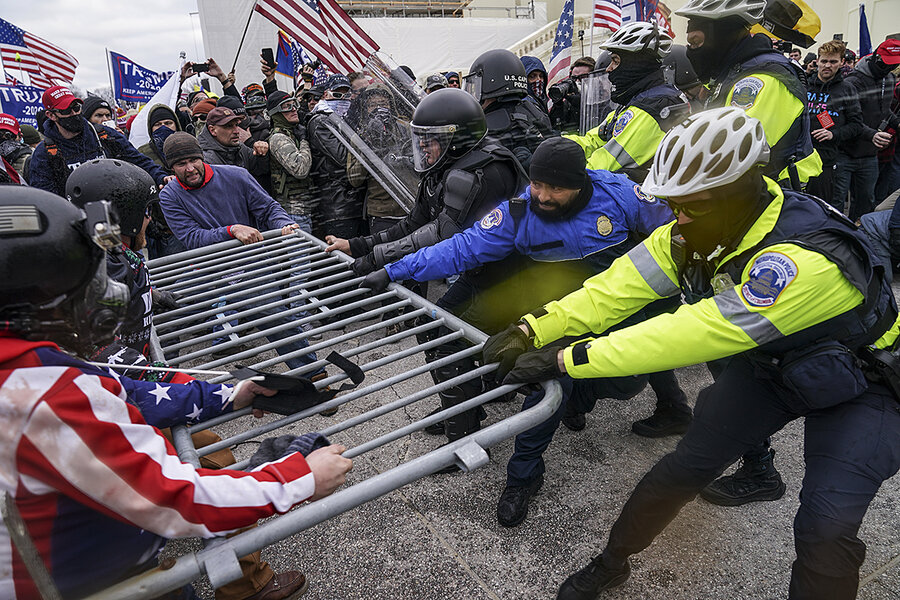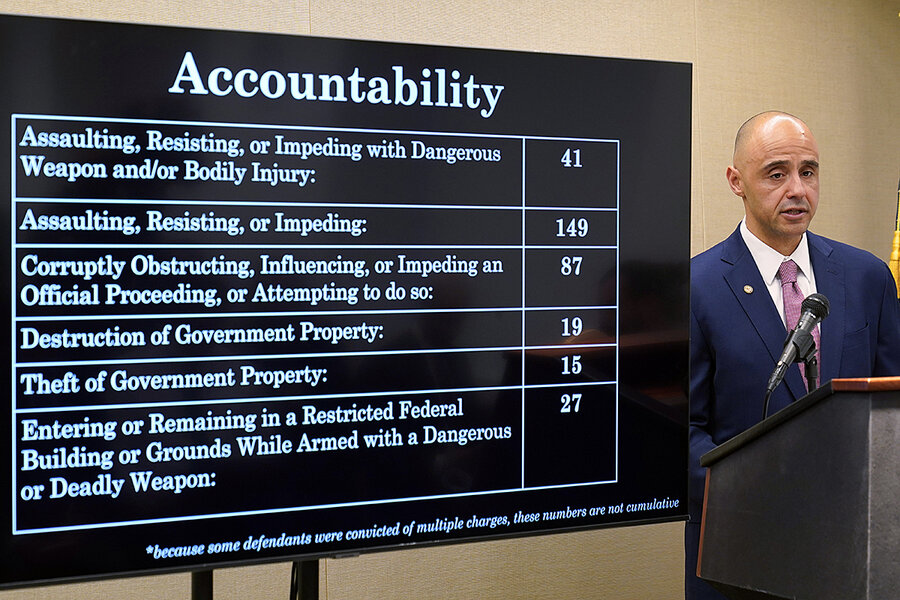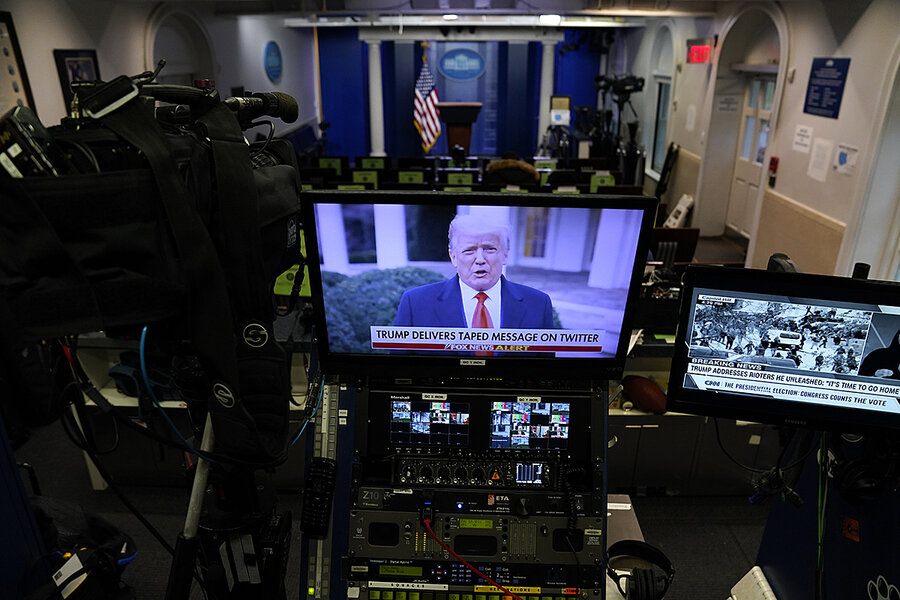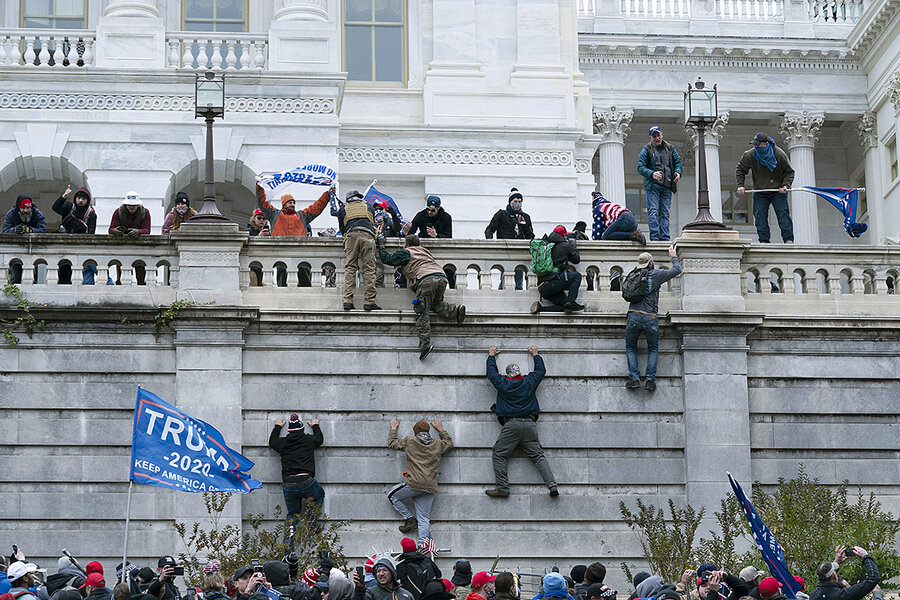How public divide over Jan. 6 could shape 2024 – and beyond
Loading...
| Washington
In the three years since the Jan. 6 breach of the U.S. Capitol, Congress has issued nearly 1,000 pages of official reports about it. Police attacked by rioters have published memoirs. Media outlets have devoted millions of words to the subject.
And more than 1,200 cases have been chugging through federal courts, producing reams of additional evidence.
Why We Wrote This
Perceptions of Jan. 6, 2021, aren’t just about the past. Diverging views of the U.S. Capitol riots may influence the political path ahead and trust in government.
But while America may be swimming in facts about Jan. 6, Americans don’t agree on the meaning of that day. Democrats and Republicans have always viewed Jan. 6 differently – and those differences have only grown wider with time, according to a new survey out this week.
Now a possible Biden-Trump rematch is on the horizon. How Americans think about Jan. 6 – in particular, how serious a threat they think it represented, who they believe was at fault, and whether they think the narratives have been skewed for political purposes – seems likely to shape not just the lessons drawn from a historic day but also America’s path forward.
“What’s going on in the present always influences interpretations of the past,” says history professor Alexander Keyssar of Harvard University. “But it’s the interpretations of the past that shape how you see the present.”
In the three years since the breach of the U.S. Capitol on Jan. 6, 2021, Congress has issued nearly 1,000 pages of official reports about it. Police attacked by rioters have published memoirs. Media outlets have devoted millions of words to the subject.
More than 1,200 cases have been chugging through federal courts, producing reams of additional evidence.
But while America may be swimming in facts about Jan. 6, Americans don’t agree on the meaning of that day. Polls show that Democrats and Republicans have always viewed Jan. 6 differently – and those differences have only grown wider with time. A new survey out this week finds that while a narrow majority of Americans think Jan. 6 was “an attack on democracy that should never be forgotten,” only 24% of Republicans hold that view, compared with 86% of Democrats. The percentage of Republicans saying that then-President Donald Trump bears responsibility for the riot has dropped by nearly half since 2021, and fewer agree today that Jan. 6 protesters were “mostly violent,” according to the poll, jointly conducted by The Washington Post and the University of Maryland.
Why We Wrote This
Perceptions of Jan. 6, 2021, aren’t just about the past. Diverging views of the U.S. Capitol riots may influence the political path ahead and trust in government.
With a possible Biden-Trump rematch on the horizon, this widening schism could have direct repercussions on this year’s presidential election and beyond. How Americans think about Jan. 6 – in particular, how serious a threat they think it represented, whom they believe was at fault, and whether they see narratives as having been skewed for political purposes – seems likely to shape not just lessons drawn from a historic day but also America’s path forward.
“What’s going on in the present always influences interpretations of the past. But it’s the interpretations of the past that shape how you see the present,” says Alexander Keyssar, a professor of history and social policy at Harvard University. “Societies and nations historically have run into very deep trouble when a majority of the people accept lies about themselves and accept false versions of the history that has brought them to the place they are in.”
What happened that day?
On Jan. 6, 2021, as Congress was preparing to make Joe Biden’s victory official, tens of thousands of Americans came to Washington in a show of support for then-President Trump.
Amid the pandemic, changes to state election rules had paved the way for unprecedented levels of mail-in voting, which Mr. Trump had relentlessly criticized. Many of his supporters believed his unfounded claims of massive election fraud, despite the courts repeatedly rejecting those arguments. They wondered how Mr. Trump could have won 11.2 million more votes in 2020 than in 2016, yet still lost the race to Mr. Biden. (Mr. Biden set a record in 2020 for most votes ever won by a presidential candidate.)
What happened next has been described alternately as a premeditated insurrection, a riot, or a rally that got out of hand. The Electoral College vote count was disrupted for hours, with members of both the Senate and House abruptly evacuated as rioters broke through police barricades and smashed windows and doors, opening the way for hundreds more to stream into the Capitol. More than 140 law enforcement officers were injured in the melee, and several died in the weeks and months to come. At least three protesters also died that day, including one shot by a Capitol Police officer while trying to crawl through a shattered door panel outside the House chamber.
One challenge in characterizing what happened is that the crowd included a wide range of actors with apparently different intentions. Some came from known extremist groups and brought tactical gear and cans of bear and pepper spray. Others were there with baby strollers and American flags.
Mr. Trump is among the more than 1,200 defendants charged for their role that day. Oath Keepers founder Stewart Rhodes was convicted of seditious conspiracy and sentenced to 18 years. Former Proud Boys leader Enrique Tarrio, apprehended in Washington just ahead of Jan. 6, was sentenced to 22 years in September.
“Today’s sentencing demonstrates that those who attempted to undermine the workings of American democracy will be held criminally accountable,” said FBI Director Christopher Wray, who pledged the bureau would always protect Americans’ First Amendment rights.
But for the hundreds of those protestors arrested for misdemeanors, many feel those rights have been trampled.
Dustin and Karla Adams of Hillsdale, Michigan, whose local GOP organized two charter buses to go to Washington for the Jan. 6 rally, spent six minutes in the Capitol, according to the FBI. This September, they were informed they would face misdemeanor charges. They turned themselves in to the FBI and were released on $10,000 unsecured bonds.
Of the more than 1,200 defendants, only two have been acquitted so far. That can be disheartening to those accused, says the Adamses’ lawyer, Daren Wiseley, in a phone interview. Many have taken plea deals instead of pursuing lengthy and costly litigation against the well-resourced federal government.
“In my opinion, it’s designed to break the spirit,” says Mr. Wiseley, who knew the Adamses prior to Jan. 6 and is taking their case pro bono.
Jonathan Lewis, a research fellow with the Program on Extremism at George Washington University in D.C., says that for many who truly thought they were on the right side of history, their subsequent arrests and legal woes have fueled a sense of being punished for their political beliefs.
Still, he adds, the narrative that Jan. 6 defendants are “political prisoners” who have been mistreated is largely unfounded.
For example, one oft-repeated claim – that many were unjustly kept in solitary confinement – ignores the fact that under pandemic health protocols, the use of solitary detention spiked by 500% across the country, including in the Washington jail where many Jan. 6 prisoners were kept.
Of the 44% of defendants who have been sentenced so far, about half were sentenced to a month or less in jail, according to an open records analysis by Look Ahead America, a nonprofit that advocates for “rural and blue-collar patriotic Americans.” Only 5% got five years or more.
Just 1 in 10 cases are closed, however, with many dragging on as defendants and their lawyers seek to challenge how evidence was collected, request more time to obtain and review video footage, or try to get their trials moved out of Washington, where only 5% of voters supported Mr. Trump in 2020.
Defendants and their allies in Congress and elsewhere have also alleged that they are being treated more harshly than protesters involved in violence during the 2020 racial justice protests. An NBC affiliate in Portland, Oregon, where leftist protesters repeatedly targeted a federal courthouse and clashed with law enforcement, reported in March 2021 that the federal government had quietly dropped a third of cases brought against the protesters.
Jan. 6 defendants have also questioned the applicability of laws used to charge them, including a provision that came out of the Enron Corp. scandal. Known as Section 1512, it carries up to a 20-year sentence for destroying evidence or otherwise obstructing an official proceeding. Last month, prompted by a defendant’s appeal, the Supreme Court agreed to look into whether prosecutors exceeded the provision’s scope by applying it to roughly 300 Jan. 6 cases – including Mr. Trump’s.
Who is responsible?
A key question working its way through not only legal channels but also the court of public opinion is who is responsible for the violence that day.
The House committee on Jan. 6 focused on Mr. Trump as the main culprit, blaming him for bringing the country to the brink of a constitutional crisis. According to testimony and records compiled by the committee, Mr. Trump doubled down on claims of election fraud that his inner circle had repeatedly advised him were unfounded, inappropriately pressured state legislators and members of Congress to challenge the results, and – after encouraging his supporters to march to the Capitol on Jan. 6 – watched the violence unfold for hours on TV before taking any meaningful steps to try to stop it.
Chair Bennie Thompson, a Mississippi Democrat whose father was prevented from voting by Jim Crow laws, wrote in his forward to the committee’s final report: “Our country has come too far to allow a defeated President to turn himself into a successful tyrant by upending our democratic institutions, fomenting violence, and, as I saw it, opening the door to those in our country whose hatred and bigotry threaten equality and justice for all Americans.”
Others have focused on evidence that members of the Proud Boys and Oath Keepers came to Washington planning for violence, coordinating for weeks on encrypted platforms and depositing weapons nearby if needed. On their own, the conspirators wouldn’t have been able to break into the Capitol, says Mark Denbeaux, director of Seton Hall Law School Center for Policy and Research and author of the paper “The January 6 insurrectionists: Who they are and what they did.”
“Conspirators knew there would be a mob there and were relying on that,” he says, adding that many of the people caught up in that mob “were duped.”
But according to the same Washington Post poll, a quarter of Americans now believe that the government itself instigated the riot – a theory denied by the government but which right-wing media and politicians have persistently raised. A third of Republicans and 44% of Trump voters, said they think that it’s “definitely” or “probably” true that FBI operatives organized and encouraged the attack on the U.S. Capitol on Jan. 6, 2021, something the Department of Justice has adamantly denied. By contrast, only 13% of Democratic respondents shared that view.
Experts on domestic extremism say while there are legitimate concerns about the FBI’s use of undercover agents and informants, historically used mainly against left-leaning organizations, they largely don’t apply to Jan. 6.
Michael German, a former FBI undercover agent who left the bureau in 2004 and is now at the Brennan Center for Justice’s Liberty and National Security Program, says false narratives are often constructed by pointing to a true thing that happened to a different group – such as the use of FBI informants and undercover agents in the 2020 kidnapping plot against Michigan Gov. Gretchen Whitmer.
“I’ll criticize that technique no matter who it’s targeting,” he says. “But in reality, it’s very rarely targeted against white militants.”
Steven D’Antuono, who led the FBI’s Detroit field office during the Whitmer plot before being promoted to the D.C. field office, confirmed in an interview this summer with House Republicans that there were informants (“confidential human sources”) in the crowd on Jan. 6, though he said he didn’t know the precise number.
Defendants and their supporters have persistently raised questions about potential instigators. In particular, they have focused on Ray Epps, a retired Marine and former chapter leader of the Oath Keepers captured on video the night of Jan. 5 encouraging Trump supporters to go into the Capitol, and who can be seen in Jan. 6 video clips near the front lines. Because the DOJ did not charge him until this September, many on the right voiced suspicions that he was working with – and being protected by – federal officials. The FBI denies that it employed Mr. Epps, who has since moved several times, citing death threats. He has sued Fox News for defamation and is reportedly in hiding. He will be sentenced next week.
He told the Jan. 6 committee that he has never worked as a government informant.
“Sincere fear and anger ... makes people malleable to these conspiracy theories,” says Brian Levin, founder of the Center for the Study of Hate and Extremism at California State University, San Bernardino. He points to a feeling of diminished status among white working-class males and widespread distrust in government institutions. “When people have less hope, when they don’t understand the dynamics of why change is occurring, it’s easier to foist that onto some perceived evil-doer.”
The meaning for 2024 and beyond
Mr. Lewis of George Washington University says that while the Jan. 6 House committee did a good job delivering a blow-by-blow account of that day’s events, it didn’t do enough to examine root causes or intelligence and security failures. “More broadly, there’s been a failure to look at the uncomfortable realities about what Jan. 6 can tell us about domestic extremism and political violence in the U.S.,” he adds.
Professor Keyssar of Harvard says he worries that the impulse to downplay what happened on Jan. 6 could lead to a greater tolerance for violence going forward. “To accept this Trumpian version of what happened in January 2021 is in effect to accept the violence that occurred there and therefore to accept violence as a form of political protest,” he says.
When asked how students may read about Jan. 6 in textbooks 100 years from now, he says it’s possible that someday “this entire alarming episode might look like a blip in U.S. history.” But he thinks it’s more likely to be seen as a pivotal moment.
“This is some kind of inflection point in U.S. history,” he says. “And we don’t quite know – we don’t know at all – what the real upshot is going to be.”
Staff writer Sophie Hills contributed reporting.













